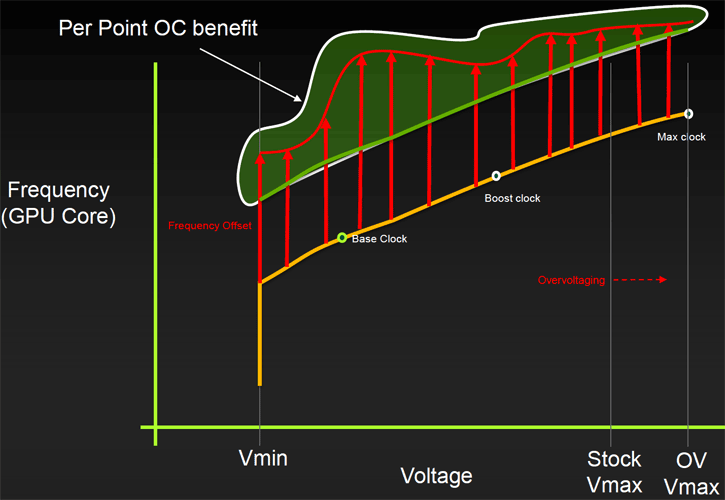Introduction
A Little Extra Turbo Boost for your 1080 Sir?
Last week you guys have been able to read up on all the glory there is to be found regarding the GeForce GTX 1080. And though we briefly touched on the topic of overclocking in our reference article, there's was one bit missing; extended tweaking performance with AfterBurner. We really wanted to publish a separate article on it as a thing or two have changed with the new Pascal GPU product series that deserve some explaining.
Overclocking never comes without risk, but it sure as heck is interesting to see how far you can take a card. As such today an article dedicated on overclocking the GeForce GTX 1080. You will notice that if you go for long lifespan that overclocking the old fashioned way will not disappoint. A good 1900 MHz on the GPU (reference air cooler) is certainly something you can achieve really easily. However with Nvidia's updated Dynamic Clock Adjustment technology (GPU Boost 3.0) things have changed a bit. Regardless of that you'll be able to tweak a lot more performance out of this complex 7.2 Billion transistor GPU, more than you think.
GPU Boost
Ever since the launch of Kepler and Maxwell GPUs the mainstream and high-end SKUs feature a Dynamic Clock Adjustment technology and we can explain it easily without any complexity. Typically when your graphics card is idle, the cards clock frequency will go down... yes? Well, obviously Pascal architecture cards will do this as well, yet it can work vice versa. If in a game the GPU has room left for some more, it will increase the clock frequency a little which adds some extra performance. You could say that the graphics card is maximizing it's available power threshold and target and other monitor registers. All this is managed by a dedicated hardware circuitry that monitors various aspects of the graphics card, from the GPU's power consumption and temperature to the actual GPU and memory utilization. All that information is processed by the GPU Boost software algorithm to determine what changes, if any, should be made to the GPU and memory clock speeds and voltages.
So what's new?
New starting at GeForce GTX 1070/1080 is a Utilization target, basically GeForce GTX 1080 monitors how much load an application producesand will try and match a certain target by downclocking. There's also a power limiter, OV max limiter, Voltage limiter, heck even SLI limiter and a temperature limiter. The nominal and default baseline temperature is 80 degrees Celsius. That is the balance in-between an acceptable temperature versus low noise levels versus Power consumtion. If you configure the temperature target at 90 degrees and the power target has room left then 1080 will increase the GPU Voltage a little bit. It'll then clock faster on the Turbo frequency until it reaches the now new temperature, power and or GPU utilization targets. Overclocking on that end will work the same as GPU boost will continue to work while overclocking, it stays restricted within a defined bracket. Boost 3.0 however brings in new features for voltage tweaking. Typically a GPU clock frequency was fixed at a certain MHz, they altered that to a base frequency, and then a Boost frequency. That Boost frequency would allow the GPU to reach high clocks if, say, the temperature of the GPU is low enough, or say the GPU would have low enough load. So, ever since it was introduced, dynamic clock frequencies and voltages have become a popular thing, Nvidia calls this Nvidia Boost, and it has now reached revision three.
A fundamental change has been made as the GPU is now even more adaptive and allows for per voltage point offsets. Meaning at certain stages on the GPU voltage clocks you will have a certain tolerance in your GPU Core frequency that point can take. The advantage here is that each stage can get a more optimal boost frequency (relative to voltage) and thus overclocking frequency. It looks complex, but does offer a new technology to make these cards run faster at even higher clock frequencies.
So basically new addition would be:
- Adjust per point vlock frequency frequency offset (controlled by the end user).
- Overvoltage setting mode changes (exact voltage->set range 0%~100%), voltages are now based on percentage .
- Add new limit option -> No load limit (=utilization limit)
- This new NVAPI only supports PASCAL GPUs. meaning the new features that we discuss and sho today only will work on GEForce GTX 1070 and 1080 (and other TBA products).
Basically with future updates in overclocking software you will see mutilple stages of control:
- Regular voltage control in percentage (no longer can fixed/exact Voltage offsets be used). MsAximum voltage will vary based on temperature.
Then on the GPU core frequency:
- Basic mode - a single clock frequency offset applied to all V/F points.
- Linear mode control - You can specify a frequency offset for the maximum clock and minimum clocks. In AfterBurner this linearly interpolates to fill a curve.
- Manual mode - per point frequency offset control through the V/F editor in AfterBurner.


